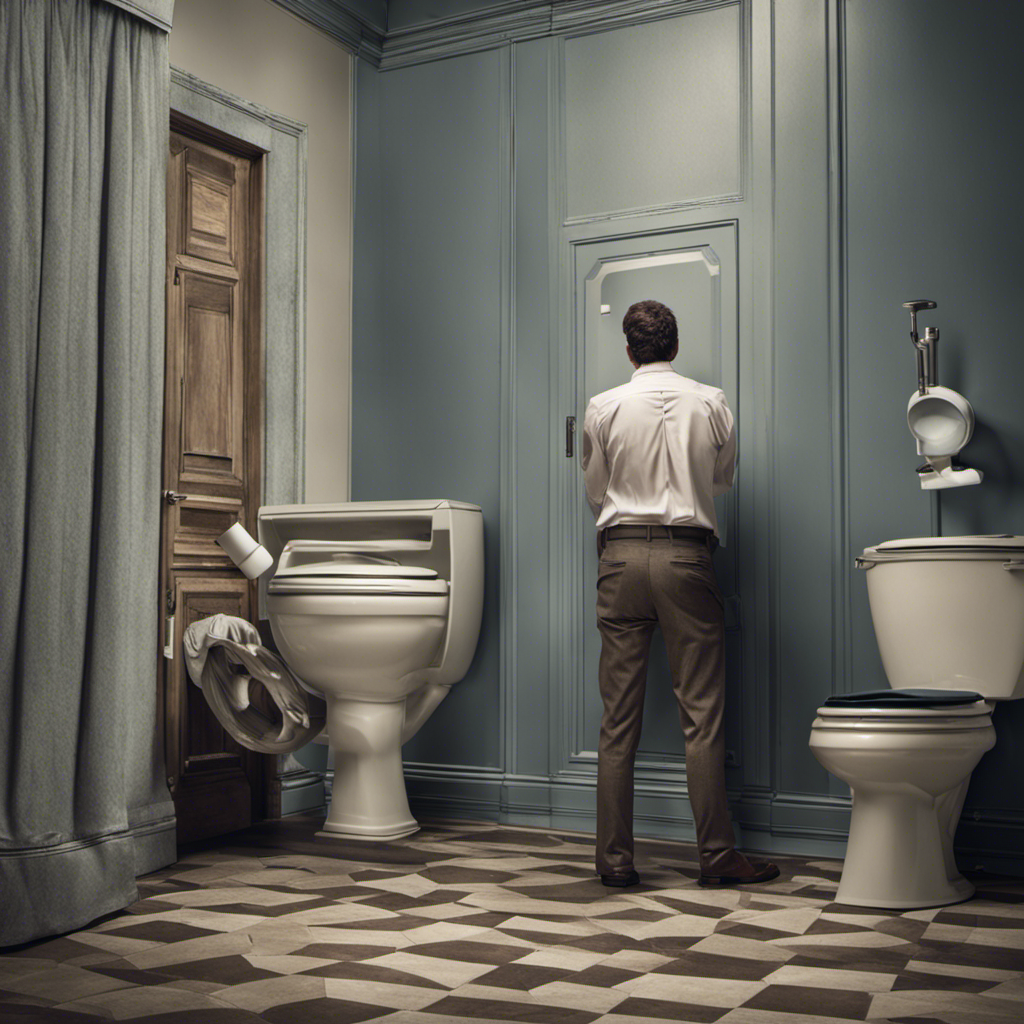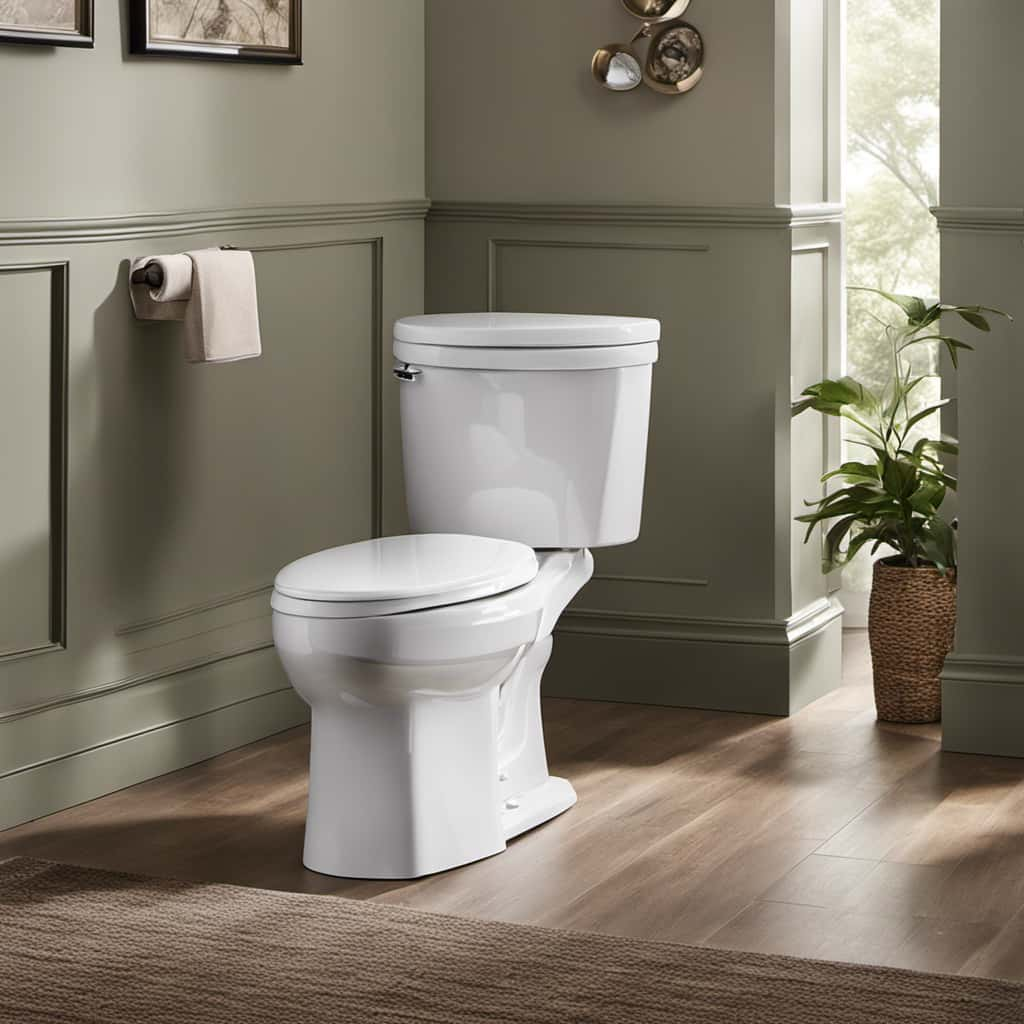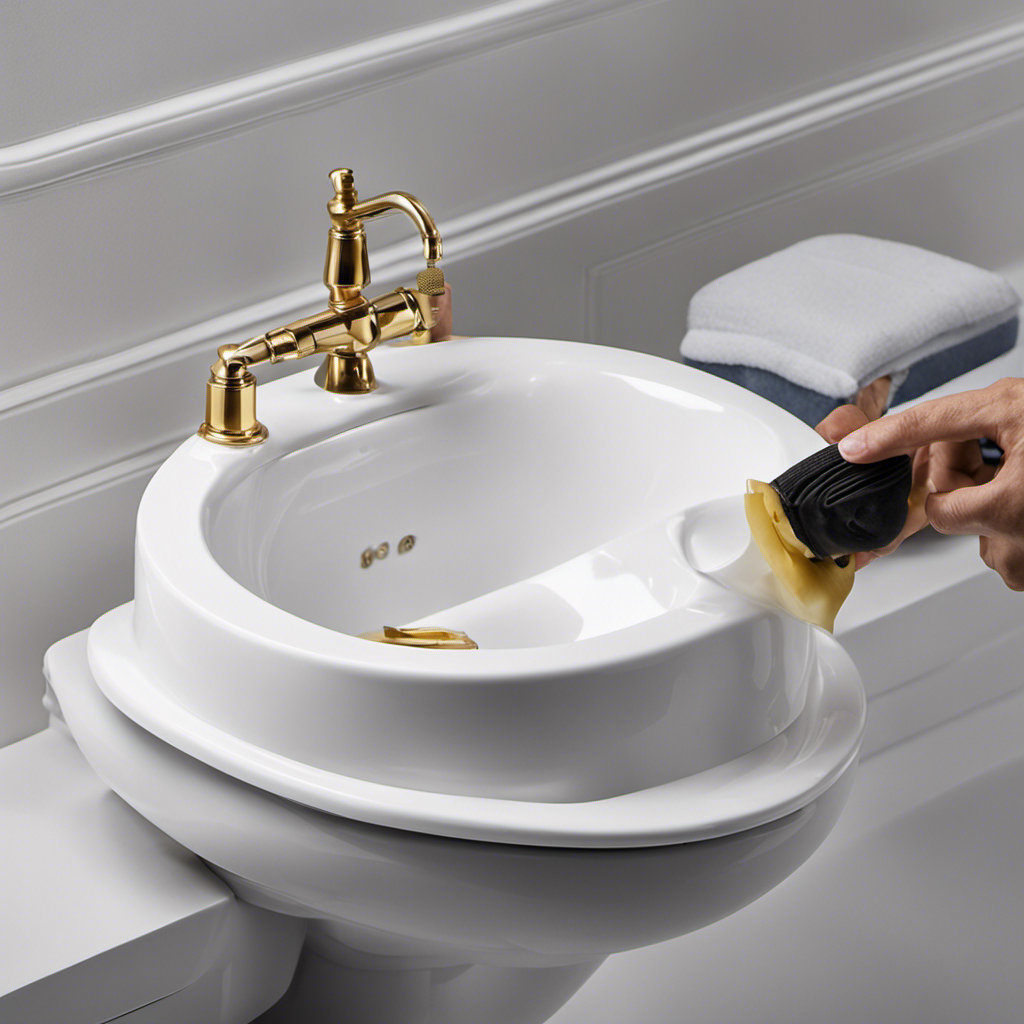I’ve had my fair share of frustrating moments when my toilet simply refuses to flush. It’s a problem that can disrupt our daily routines and leave us feeling helpless.
But fear not, because in this article, I’ll dive into the possible reasons behind your toilet’s flushing issues and provide you with practical solutions.
From troubleshooting non-flushing toilets to understanding the importance of water pressure, we’ll cover it all.
So, sit tight and get ready to bid farewell to your toilet troubles.
Key Takeaways
- Possible reasons for toilet flushing issues include problems with the toilet tank, leaks or blockages in the tank, malfunctioning flush handles, and loose or broken handles.
- Common toilet flushing problems can be solved by checking for clogs in the toilet trap, adjusting the water level in the tank, and addressing malfunctioning flapper valves.
- Water level adjustments are important as low water levels can cause weak flushes and clogs. Fill valves and floats should be checked and adjusted if necessary, and any obstructions in the water supply line should be cleared.
- Steps to troubleshoot a non-flushing toilet include checking the water level in the tank, adjusting the fill valve if needed, ensuring the chain connecting the flapper to the flush handle is properly connected, and checking the flapper for a tight seal.
Possible Reasons for Toilet Flushing Issues
If your toilet isn’t flushing, there could be a few possible reasons for the issue.
One common reason is a problem with the toilet tank. The toilet tank is responsible for holding the water that is used to flush the toilet. If there is a leak or a blockage in the tank, it can prevent the toilet from flushing properly.
Another possible reason is a malfunctioning flush handle. The flush handle is what you use to activate the flushing mechanism in the toilet. If the handle is loose, broken, or not connected properly, it can prevent the toilet from flushing.
It is important to check both the toilet tank and the flush handle to identify and resolve any issues that may be causing your toilet not to flush.
Common Toilet Flushing Problems and Solutions
When it comes to common toilet flushing problems, there are a few key points to consider. Weak flush solutions can be addressed by checking for any clogs in the toilet trap or adjusting the water level in the tank.
Clogged toilet fixes may involve using a plunger or a toilet auger to remove any obstructions in the pipe.
Weak Flush Solutions
To improve your weak flush, try adjusting the water level in the toilet tank. The water level in the tank determines the force with which water enters the toilet bowl during a flush. If the water level is too low, the flush will be weak.
Start by locating the water level adjustment screw or valve on the fill valve assembly, usually found on the left side of the tank. Turn the screw or adjust the valve clockwise to increase the water level. Be careful not to raise it too high, as this can cause water to overflow into the overflow tube.
Another possible cause of a weak flush is a malfunctioning flapper valve. Inspect the flapper valve and replace it if necessary.
Clogged Toilet Fixes
One way to fix a clogged toilet is by using a plunger. This simple tool can be highly effective in unclogging toilets.
Here are some toilet plunging techniques and DIY unclogging methods to consider:
- Position the plunger over the drain hole, ensuring a tight seal.
- Push down firmly, then pull up sharply to create suction.
- Repeat this plunging motion several times to dislodge the clog.
- If the plunger doesn’t work, try using a toilet auger to reach deeper clogs.
Water Level Adjustments
Adjusting the water level in the toilet tank can often resolve issues with a clogged toilet. It is important to understand the importance of water level adjustment in order to troubleshoot low water level problems effectively.
The water level in the toilet tank should be set at a specific height to ensure proper flushing. If the water level is too low, it can result in weak or incomplete flushes, leading to clogs.
To troubleshoot low water level, start by checking the fill valve and adjusting it if necessary. Make sure the float is not set too low, as this can also cause low water level. Additionally, check for any obstructions or blockages in the water supply line.
Steps to Troubleshoot a Non-Flushing Toilet
If your toilet isn’t flushing, you can start by checking the water level in the tank. Ensure that the water level is at the appropriate mark, usually indicated by a fill line. If the water level is too low, you may need to adjust the fill valve to allow more water in. If the water level is too high, you can adjust the float ball or float cup to lower it.
Additionally, check if the chain connecting the flapper to the flush handle is properly connected and not tangled. Finally, make sure that the flapper is sealing tightly and not allowing water to leak into the bowl.
These steps should help troubleshoot and resolve common issues with toilet flushing.
Now, let’s explore signs that indicate a faulty toilet flushing mechanism.
Signs That Indicate a Faulty Toilet Flushing Mechanism
In my experience as a plumber, I’ve encountered two common issues with toilet flushing mechanisms. The first issue is weak water flow, which can be caused by various factors. These include a partially closed water valve, a malfunctioning fill valve, or a blockage in the water supply line.
The second issue is constant clogging, which may be a result of a faulty flapper valve, a blocked trapway, or improper waste disposal.
Understanding these key points is crucial in troubleshooting and resolving toilet flushing problems.
Weak Water Flow
You might want to check if the water flow in your toilet is weak. Weak water flow can be a sign of a problem with your toilet’s flushing mechanism. Here are a few troubleshooting steps you can take to address this issue:
-
Check the water supply valve: Ensure that the water supply valve near the base of the toilet is fully open. If it’s partially closed, it can restrict water flow and cause weak flushing.
-
Clean the water inlet holes: Sediment and debris can accumulate in the water inlet holes under the rim of the toilet bowl. Use a small brush or a piece of wire to clean these holes and improve water flow.
-
Inspect the toilet flapper: A worn-out or misaligned toilet flapper can lead to weak water flow. Consider replacing the flapper to restore proper flushing.
-
Test the water pressure: Low water pressure can affect the flushing performance. Use a water pressure gauge to measure the pressure and adjust it if necessary.
Constant Clogging
The constant clogging of your toilet could be due to a blockage in the drainage pipe. When it comes to toilet flushing maintenance, it’s important to understand the common issues that can cause clogs.
One possible culprit is an accumulation of toilet paper or other debris that is obstructing the flow of water through the pipe. Another common cause is the improper disposal of items such as sanitary products or baby wipes, which can easily become trapped in the pipe and lead to clogs.
To troubleshoot a constantly clogging toilet, you can try using a plunger to dislodge the blockage or using a toilet auger to break it up. If these methods don’t work, it may be necessary to call a professional plumber for further assistance in resolving the issue.
By addressing the underlying cause of the clogs, you can ensure that your toilet flushes properly and avoid future frustrations.
Now, let’s explore how to fix a clogged toilet that won’t flush.
How to Fix a Clogged Toilet That Won’t Flush
To fix a clogged toilet that won’t flush, try using a plunger. This simple tool can help dislodge the blockage and restore the flow of water.
Here’s how to use a plunger effectively:
- Make sure the plunger‘s rubber cup fully covers the toilet bowl‘s drain opening.
- Apply downward pressure on the plunger, then pull up quickly to create suction.
- Repeat this plunging motion several times, maintaining a tight seal.
If the clog doesn’t clear after a few attempts, it may be necessary to use a toilet auger or call a professional plumber.
Remember, when using a plunger, it’s important to plunge with force but also be mindful of the water level to avoid splashing.
Understanding the Role of Water Pressure in Toilet Flushing
In order to understand why your toilet isn’t flushing properly, it’s important to consider the role of water pressure in the flushing process. Water pressure plays a crucial role in creating the force needed to efficiently flush waste down the drain. If you’re experiencing issues with your toilet’s flushing mechanism, troubleshooting the water pressure is a good place to start.
First, check the water supply valve to ensure it is fully open. A partially closed valve can result in reduced water pressure, leading to weak flushes. Additionally, inspect the fill valve and the flush valve for any signs of wear or damage. These components are responsible for regulating the flow of water during the flushing process.
Regular maintenance of the toilet’s flush mechanism is also essential. Cleaning and lubricating the moving parts can prevent any buildup or blockages that may hinder the flushing mechanism’s performance.
Professional Assistance for Persistent Toilet Flushing Problems
If you’re experiencing persistent problems with your toilet flushing, it may be beneficial to seek professional assistance. While some minor issues can be resolved with DIY methods, persistent flushing problems may indicate a more complex underlying issue that requires the expertise of a professional plumber.
Here are some reasons why professional assistance is crucial in such situations:
-
Expert Diagnosis: A professional plumber can accurately diagnose the cause of the flushing problem, whether it’s a clog, a faulty valve, or a problem with the water supply.
-
Specialized Equipment: Plumbers have access to specialized tools and equipment that can help them identify and fix the issue efficiently.
-
Proper Repairs: Professionals have the knowledge and experience to perform repairs or replacements correctly, ensuring that the flushing problem is resolved effectively.
-
Preventing Further Damage: By seeking professional assistance, you can prevent further damage to your toilet system and avoid costly repairs in the future.
Frequently Asked Questions
How Do I Know if My Toilet Flushing Mechanism Is Faulty?
To determine if your toilet flushing mechanism is faulty, check for common issues like a broken handle or a clogged flapper. If troubleshooting doesn’t work, consider calling a professional for toilet flushing mechanism repair.
What Should I Do if My Toilet Is Clogged and Won’t Flush?
If my toilet is clogged and won’t flush, I would start by using plunger techniques and DIY toilet unclogging methods. These methods are effective in clearing blockages and restoring proper flushing functionality.
Can Low Water Pressure Cause Toilet Flushing Issues?
Low water pressure can indeed cause toilet flushing issues. When the pressure is low, the toilet may not have enough force to effectively flush waste down the drain. This can be due to various factors, such as clogged pipes or malfunctioning toilet flushing accessories.
When Should I Seek Professional Assistance for Persistent Toilet Flushing Problems?
When facing persistent toilet flushing problems, it’s important to know when to seek professional assistance. Troubleshooting toilet flushing problems can be complex, and if regular toilet flushing maintenance doesn’t solve the issue, it’s time to call the experts.
Are There Any Signs or Symptoms That Indicate a Non-Flushing Toilet?
When troubleshooting toilet flushing problems, it’s important to know the signs of a non-flushing toilet. Look out for weak flushes, water rising but not draining, or a complete lack of flushing. Proper toilet clog prevention can help avoid these issues.
Conclusion
After exploring the various reasons and solutions for a non-flushing toilet, it is clear that troubleshooting and fixing this issue requires both knowledge and technical expertise.
From clogs to faulty mechanisms, every aspect of the toilet flushing system must be examined thoroughly. By understanding the role of water pressure and seeking professional assistance when needed, one can ensure a well-functioning toilet.
So, next time your toilet refuses to flush, don’t panic! With the right approach, you’ll have it flowing smoothly again in no time, like a gentle stream carving its way through a pristine landscape.










